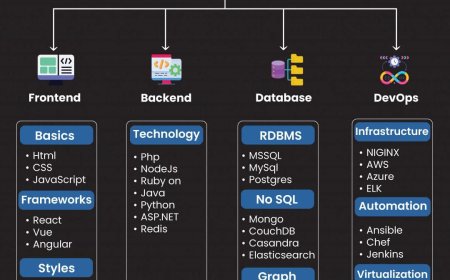How UX/UI Design Impacts the Success of Your Mobile App
Discover how UX and UI design shape the user experience and determine your mobile app’s success. Learn why thoughtful design is key in 2025 and how to get it right from the start.

Understanding Why UX/UI Design Matters
When people think about mobile apps, the first things that come to mind are speed, convenience, and ease of use. These arent just featuresthey're the result of strong design. A great mobile app development company in USA understands that the design layer, specifically UX (user experience) and UI (user interface), is what makes or breaks your app. No matter how advanced your backend is, if the interface isnt friendly, users wont stick around.
Whats the Real Difference Between UX and UI?
User Experience (UX): Feeling the Flow
UX focuses on how your app behaves from the users point of view. It's about ease, logic, and the overall journey people take when using your product. Smooth navigation, fast performance, and satisfying task completionall fall under UX.
User Interface (UI): The Visual Story
UI is what users see and touch. It's made up of the layout, color scheme, typography, buttons, and visuals. User Interface (UI) brings the brand's personality to life and ensures clear communication in every interaction.
Why Strong Design is Essential in 2025
First Impressions Stick
In a world where users decide in seconds whether to keep or delete an app, your design must impress immediately. Poor design leads to frustration; great design makes users feel at home.
Standing Out in a Crowded Market
There are millions of apps out there. Having a polished, intuitive design isn't just niceits your edge. It helps your product stay relevant and memorable in a sea of choices.
How Smart UX Solves Real User Problems
Thinking Like the User
Design should match how people naturally think. That means reducing clicks, guiding users clearly, and offering instant feedback when they take action. A logical layout reduces friction and makes tasks quicker.
Microinteractions That Add Delight
Small animations or soundslike a vibration when you complete a goalmight seem minor, but they create emotional connections and enhance usability.
Core Elements of an Effective UI
Keep It Clean and Clear
Avoid clutter. A clean design with clear hierarchy helps users focus and act without confusion. Stick to a consistent layout and keep important features accessible.
Designing for Thumbs, Not Mice
Make sure buttons are large enough to tap. Keep key actions within thumb rangethis small tweak alone improves the mobile experience dramatically.
Designing Before You Build
Start with Sketches and Wireframes
Before diving into development, outline how the app will work. Use wireframes to build the structure of each screen. Its like creating a house blueprint before laying bricks.
Get Feedback Early
Create simple prototypes and show them to real users. Ask questions, observe behavior, and refine based on what you learn. It saves both time and money down the road.
Dont Underestimate UX Writing
Words That Guide, Not Confuse
The little bits of text throughout your applike error messages or button labelsshould be helpful, friendly, and aligned with your brand voice. Simple words = clear actions.
Set the Right Tone
Your writing sets the vibe. Whether you're fun and playful or serious and professional, keep the tone consistent throughout the app.
Designing with Accessibility in Mind
Inclusion is Good UX
Not all users engage with your app in the same manner. Some may use screen readers, while others rely on voice commands. Design with everyone in mind.
Use the Right Tools
Contrast checkers, scalable fonts, and screen reader testing tools help make your app accessible to a wider audience.
Performance is Part of UX
Speed Matters
Even a beautiful app can be useless if it's slow. Optimize images, reduce load times, and test across devices to keep things running smoothly.
Offline Functionality is a Bonus
Allow users to access basic features even when they are offline. It improves reliability and shows you care about their experience in all situations.
Testing: Dont Launch Blindly
A/B Testing is Your Best Friend
Test different versions of your designs. A small change in color, layout, or copy can impact how users engage with your app.
Watch How People Use It
Use heatmaps or session replays to watch real user behavior. These tools highlight friction points and offer clues for improvement.
Teamwork Makes the Design Work
Designers and Developers Must Sync
Designers build the vision. Developers bring it to life. When both communicate regularly, the result is a seamless app that functions and looks great.
Use Collaboration Tools
Platforms like Figma or Zeplin allow for real-time collaboration, helping both sides stay aligned and efficient.
Avoid These Common Mistakes
Dont Overcomplicate It
More features arent always better. Focus on the core value of your app and deliver that flawlessly before adding extras.
Listen to Your Users
Pay attention to feedback. What seems cool to the designer might be frustrating to the end user. Let actual data and user voices guide updates.
Fresh Design Trends to Watch in 2025
Minimal, But Meaningful
Clean layouts and subtle animations continue to dominate. Users dont want to guessthey want clarity.
Customization Through AI
Apps are becoming smarter. Personalized experiences based on behavior are now expected, not optional.
How to Measure Good UX
Look at the Numbers
Monitor metrics like task success rate, bounce rate, and average session time. These indicators show how well users are interacting with your app.
Ask for Feedback
Use surveys or feedback forms within the app. Honest insights from users are invaluable for improvement.
Examples of Success (and Failure)
Apps That Nailed It
Apps like Notion and Spotify win because of their simplicity, speed, and consistency. They dont overwhelm usersthey guide them.
Apps That Missed the Mark
Apps that crash often, lag, or confuse users with poor layout usually dont last long. Most are uninstalled within minutes.
Final Thoughts
Design is not just an afterthoughtit is the foundation of your app's success. A smooth, intuitive, and inclusive user experience makes people love and recommend your app. If you're serious about creating an app people enjoy using, consider working with a seasoned iPhone app development company that values design just as much as development.
Frequently Ask Questions
1. Whats the main difference between UX and UI?
Ans: UX is how the app feels; UI is how it looks. UX focuses on the flow and function, while UI handles the visuals and interactions.
2. Can design really affect my apps success?
Ans: Absolutely! Good design keeps users engaged and reduces uninstalls. Poor design drives users away fast.
3. How early should I think about UX/UI?
Ans: From the start. Design decisions should influence development, not come after it.
4. What tools help improve app design?
Ans: Figma, Adobe XD, Sketch, and usability testing tools like Maze or Hotjar are great for modern app design.
5. How do I make my app more accessible?
Ans: Use readable fonts, high-contrast colors, and ensure compatibility with screen readers. Always test your app with different user needs in mind.
























